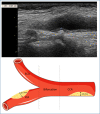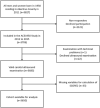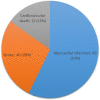Carotid Plaque Score for Stroke and Cardiovascular Risk Prediction in a Middle-Aged Cohort From the General Population
- PMID: 37609981
- PMCID: PMC10547315
- DOI: 10.1161/JAHA.123.030739
Carotid Plaque Score for Stroke and Cardiovascular Risk Prediction in a Middle-Aged Cohort From the General Population
Abstract
Background We aimed to explore the predictive value of the carotid plaque score, compared with the Systematic Coronary Risk Evaluation 2 (SCORE2) risk prediction algorithm, on incident ischemic stroke and major adverse cardiovascular events and establish a prognostic cutoff of the carotid plaque score. Methods and Results In the prospective ACE 1950 (Akershus Cardiac Examination 1950 study), carotid plaque score was calculated with ultrasonography at inclusion in 2012 to 2015. The largest plaque diameter in each extracranial segment of the carotid artery on both sides was scored from 0 to 3 points. The sum of points in all segments provided the carotid plaque score. The cohort was followed up by linkage to national registries for incident ischemic stroke and major adverse cardiovascular events (nonfatal ischemic stroke, nonfatal myocardial infarction, and cardiovascular death) throughout 2020. Carotid plaque score was available in 3650 (98.5%) participants, with mean±SD age of 63.9±0.64 years at inclusion. Only 462 (12.7%) participants were free of plaque, and and 970 (26.6%) had a carotid plaque score of >3. Carotid plaque score predicted ischemic stroke (hazard ratio [HR], 1.25 [95% CI, 1.15-1.36]) and major adverse cardiovascular events (HR, 1.21 [95% CI, 1.14-1.27]) after adjustment for SCORE2 and provided strong incremental prognostic information to SCORE2. The best cutoff value of carotid plaque score for ischemic stroke was >3, with positive predictive value of 2.5% and negative predictive value of 99.3%. Conclusions The carotid plaque score is a strong predictor of ischemic stroke and major adverse cardiovascular events, and it provides incremental prognostic information to SCORE2 for risk prediction. A cutoff score of >3 seems to be suitable to discriminate high-risk subjects. Registration Information clinicaltrials.gov. Identifier: NCT01555411.
Keywords: atherosclerosis; cardiovascular disease; carotid plaque; prediction; stroke; ultrasonography.
Figures




References
-
- Adams HP Jr, Bendixen BH, Kappelle LJ, Biller J, Love BB, Gordon DL, Marsh EE 3rd. Classification of subtype of acute ischemic stroke. Definitions for use in a multicenter clinical trial. TOAST. Trial of Org 10172 in Acute Stroke Treatment. Stroke. 1993;24:35–41. doi: 10.1161/01.str.24.1.35 - DOI - PubMed
-
- Ihle‐Hansen H, Vigen T, Ihle‐Hansen H, Ronning OM, Berge T, Thommessen B, Lyngbakken MN, Orstad EB, Enger S, Nygard S, et al. Prevalence of carotid plaque in a 63‐ to 65‐Year‐old Norwegian cohort from the general population: the ACE (Akershus Cardiac Examination) 1950 study. J Am Heart Assoc. 2018;7:e008562. doi: 10.1161/jaha.118.008562 - DOI - PMC - PubMed
-
- Hollander M, Bots ML, Del Sol AI, Koudstaal PJ, Witteman JC, Grobbee DE, Hofman A, Breteler MM. Carotid plaques increase the risk of stroke and subtypes of cerebral infarction in asymptomatic elderly: the Rotterdam study. Circulation. 2002;105:2872–2877. doi: 10.1161/01.CIR.0000018650.58984.75 - DOI - PubMed
Publication types
MeSH terms
Associated data
LinkOut - more resources
Full Text Sources
Medical
Miscellaneous

